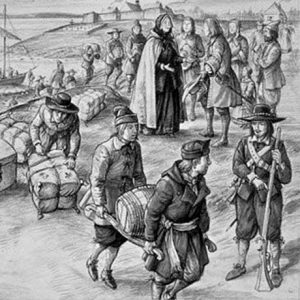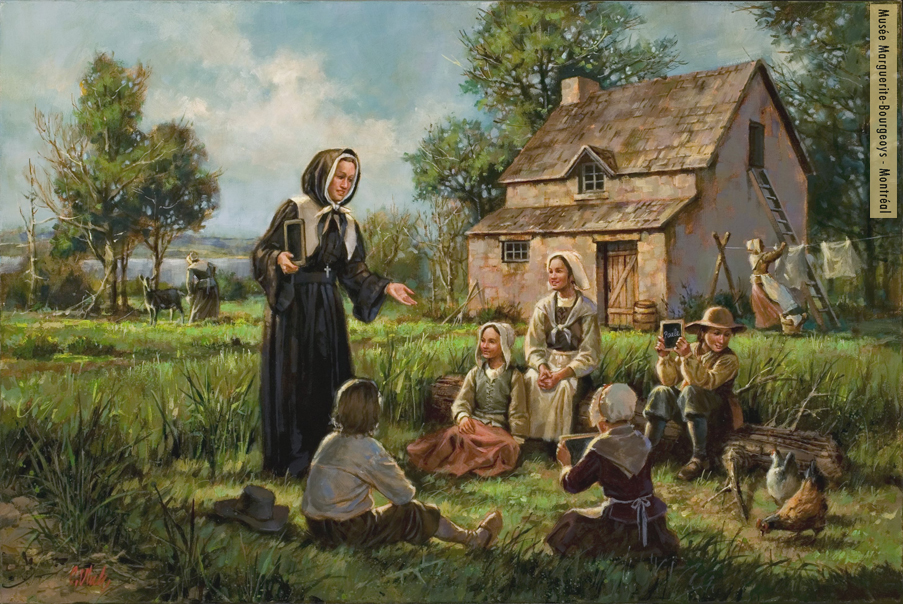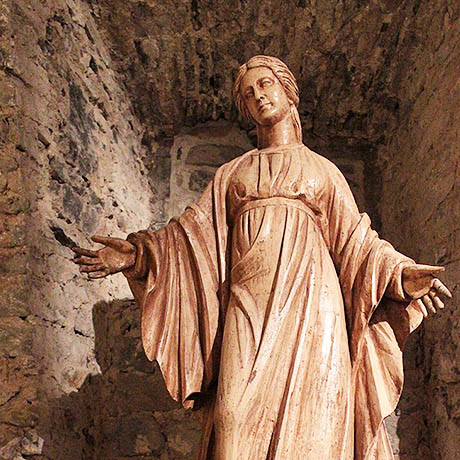
Pioneer
Marguerite Bourgeoys
Sometimes, the people placed on our path will influence the course of our destiny, as was the case with Marguerite Bourgeoys. Her encounter with Louise Chomedey, a nun from the Congregation of Notre-Dame in Troyes and the director of an external community of women, was pivotal. When Louise’s brother, Paul Chomedey de Maisonneuve, Governor of Montreal in New France, asked his sister for help in finding a teacher for the settlement, Louise suggested Marguerite, the leader of the group of young women who taught the children of the poor.


Origins
Marguerite was born in 1620 in Troyes, located in the Champagne region of France. At the age of 20, she underwent profound change in herself following a church procession and later abandoned the frivolities of life. By the time she met Monsieur de Maisonneuve, her leadership qualities and her ability to gather people around a common cause were highly recognized.
Canada Beckons
Marguerite Bourgeoys accepted de Maisonneuve's offer and agreed to accompany the recruitment of 1653, which was meant to save Ville-Marie and its fifty-some inhabitants against the attacks of the Iroquois. During the long and treacherous journeyto the New World, she became the nurse, confidante, and friend to the men and women whose arrival would triple the population of Montreal.

Woman of Vision and Warmth
Marguerite joined Maisonneuve and Jeanne Mance, the hospital administrator, as an equal in the affairs of the settlement. She understood that the women of the colony had a significant role to play in the future of Canada. Ever practical, she opened workshops where ordinary women learned skills that enabled them to earn a living. She welcomed the filles du roi whose coming provided stable families and guaranteed the survival of the country. She lived with them, prepared them for their new role and witnessed their marriage contracts.
A Chapel, a School and a Community of Women
In 1655, she rallied the inhabitants of the town to help realize her dream of building a chapel as a site of pilgrimage within easy walking distance of the settlement. After delays and some uncertainty, in 1675 Montreal’s first stone chapel was erected.
When the stable school opened in 1658, the children of the colony learned the basics of their faith, as well as counting, reading and writing. The older girls learned household skills to prepare for their responsibilities as wives and mothers. And traditionally, on the feast of Saint Catherine in November, they all made taffy!
Once the school had opened, Marguerite Bourgeoys returned to France to find companions who shared her vision. Together they formed the nucleus of the Congrégation de Notre-Dame, a community of uncloistered women. Ecclesiastical approval for such a radical lifestyle for women, unheard of at the time, was not granted until just two years before Marguerite’s death in 1700.

Back to the Beginnings
Saint Marguerite Bourgeoys was canonized in 1982. She was a pioneer, who worked in an outpost of the French empire. She built houses, established a farm and opened schools for children of the colony. She was deterred by neither bishop nor king in the pursuit of her mission. The Church presents her to us now as a model for modern times. In a moving ceremony in May 2005, the sisters of her community and the people of Montreal brought her mortal remains in procession to Notre-Dame-de-Bon-Secours chapel. They carried her through the neighbourhood where she had lived and worked and died to finally rest in her chapel, where she can be found today. A woman of courage, vision, compassion and deep spiritual strength remains with us today, part of the fabric of our lives.
For further information on Marguerite Bourgeoys, see the website of the Congrégation de Notre-Dame.
